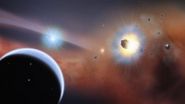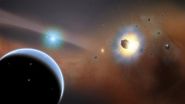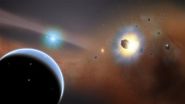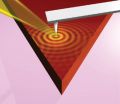(Press-News.org) In the first study of its type, researchers at the University of California, San Diego School of Medicine have looked at the health threat to pregnant women with a history of Kawasaki disease (KD), concluding that the risks are low with informed management and care.
The findings are published in the March 6, 2014 online edition of the British Journal of Obstetrics and Gynaecology.
KD is a childhood condition affecting the coronary arteries. It is the most common cause of acquired heart disease in children. First recognized in Japan following World War II, KD diagnoses are rising among children in Asia, the United States and Western Europe. Predictive models estimate that by 2020 one in every 1,600 American adults will be affected by KD.
"A growing number of women with a history of KD are reaching child-bearing age, but there is little information available to guide their obstetrical care," said study author Jane C. Burns, MD, professor and director of the Kawasaki Disease Research Center at UC San Diego and Rady Children's Hospital-San Diego. "By and large, KD is virtually unknown among working obstetricians."
KD is currently diagnosed by a constellation of clinical signs, with supporting lab tests that indicate high levels of inflammation. These signs include abrupt onset of high fever, accompanied by four of five criteria, among them: widespread rash, cracked and fissured lips, "strawberry tongue," bloodshot eyes, lymph node enlargement and red, swollen hands and feet.
Without treatment, 25 percent of children with KD develop coronary artery aneurysms – balloon-like bulges of heart vessels – that may eventually result in heart attacks, congestive heart failure or sudden death. The condition can be treated with a high-dose of intravenous immunoglobulin and aspirin, reducing the risk of aneurysms to 5 percent. The long-term risk for adults with a history of KD in childhood is not known.
Senior study author John Gordon, MD, and colleagues conducted the first KD study of non-Japanese patients, and the first to explore the health risks to women with a history of KD and their offspring. They found that the health risks for mothers with no KD-related coronary artery damage were similar to the general population. For women with aneurysms, the risks were low with appropriate management and care.
"The main message is positive," said Burns. "Women who have had KD can successfully deliver to term without complications. C-sections are not necessarily indicated if they have aneurysms, they can labor normally, if their overall cardiovascular status is OK."
There is a genetic component to KD. The study found that two of the 21 children born to the 10 women with a history of KD also developed the disease. "There is clearly an increased risk in offspring," said Burns, "but the (study) numbers are small so we cannot really calculate a risk until there is a larger population of KD adults who have had children."
INFORMATION:
Co-authors include C.T. Gordon, S. Jimenez-Fernandez and C. Shimizu, Department of Pediatrics, UCSD; L.B. Daniels and A.M. Kahn, Department of Medicine, UCSD; M. Tarsa, Department of Maternal and Fetal Medicine, UCSD; T. Matsubara, Juntendo University Urayasu Hospital; and John B. Gordon, San Diego Cardiac Center.
Funding for this research came, in part, from grants from the National Heart, Lung, Blood Institute of the National Institutes of Health (grant HL U54 HL108460), the American Heart Association and the Gordon and Marilyn Macklin Foundation.
Kawasaki disease and pregnant women
UC San Diego researchers say risks are manageable, provided doctors recognize them
2014-03-06
ELSE PRESS RELEASES FROM THIS DATE:
Early detection helps manage a chronic graft-vs.-host disease complication
2014-03-06
SEATTLE – A simple questionnaire that rates breathing difficulties on a scale of 0 to 3 predicts survival in chronic graft-vs.-host disease, according to a study published in the March issue of Biology of Blood and Marrow Transplantation.
And although a poor score means a higher risk of death, asking a simple question that can spot lung involvement early means that patients can begin treatments to reduce or manage symptoms, said senior author Stephanie Lee, M.D., M.P.H., research director of Fred Hutchinson Cancer Research Center's Long-Term Follow-Up Program, member ...
Crashing comets explain surprise gas clump around young star
2014-03-06
Beta Pictoris, a nearby star easily visible to the naked eye in the southern sky, is already hailed as the archetypal young planetary system. It is known to harbour a planet that orbits some 1.2 billion kilometres from the star, and it was one of the first stars found to be surrounded by a large disc of dusty debris [1].
New observations from ALMA now show that the disc is permeated by carbon monoxide gas.
Paradoxically the presence of carbon monoxide, which is so harmful to humans on Earth, could indicate that the Beta Pictoris planetary system may eventually become ...
ALMA sees icy wreckage in nearby solar system
2014-03-06
Astronomers using the Atacama Large Millimeter/submillimeter Array (ALMA) telescope have discovered the splattered remains of comets colliding together around a nearby star; the researchers believe they are witnessing the total destruction of one of these icy bodies once every five minutes.
The "smoking gun" implicating this frosty demolition is the detection of a surprisingly compact region of carbon monoxide (CO) gas swirling around the young, nearby star Beta Pictoris.
"Molecules of CO can survive around a star for only a brief time, about 100 years, before being ...
Galactic gas caused by colliding comets suggests mystery 'shepherd' exoplanet
2014-03-06
Astronomers exploring the disk of debris around the young star Beta Pictoris have discovered a compact cloud of carbon monoxide located about 8 billion miles (13 billion kilometers) from the star. This concentration of poisonous gas – usually destroyed by starlight – is being constantly replenished by ongoing rapid-fire collisions among a swarm of icy, comet-like bodies.
In fact, to offset the destruction of carbon monoxide (CO) molecules around the star, a large comet must be getting completely destroyed every five minutes, say researchers.
They suggest the comet swarm ...
Vitamin D increases breast cancer patient survival
2014-03-06
Breast cancer patients with high levels of vitamin D in their blood are twice as likely to survive the disease as women with low levels of this nutrient, report University of California, San Diego School of Medicine researchers in the March issue of Anticancer Research.
In previous studies, Cedric F. Garland, DrPH, professor in the Department of Family and Preventive Medicine, showed that low vitamin D levels were linked to a high risk of premenopausal breast cancer. That finding, he said, prompted him to question the relationship between 25-hydroxyvitamin D — a metabolite ...
UT Arlington study links BPA and breast cancer tumor growth
2014-03-06
UT Arlington biochemists say their newly published study brings researchers a step closer to understanding how the commonly used synthetic compound bisphenol-A, or BPA, may promote breast cancer growth.
Subhrangsu Mandal, associate professor of chemistry/biochemistry, and Arunoday Bhan, a PhD student in Mandal's lab, looked at a molecule called RNA HOTAIR. HOTAIR is an abbreviation for long, non-coding RNA, a part of DNA in humans and other vertebrates. HOTAIR does not produce a protein on its own but, when it is being expressed or functioning, it can suppress genes that ...
NASA's TRMM satellite images show California soaker moved eastward
2014-03-06
The Tropical Rainfall Measuring Mission or TRMM satellite provided a look at the rainfall associated with the large storm system that brought soaking rains to California on Feb. 28 and Mar. 1. Satellite imagery created at NASA shows the movement of the storm from the U.S. West Coast to the East Coast.
At NASA's Goddard Space Flight Center in Greenbelt, Md. images were created using data from the TRMM Microwave Imager (TMI) instrument that showed the movement of recent stormy weather from California's Pacific Ocean coast to the Atlantic Coast. TRMM is a satellite managed ...
NASA's THEMIS discovers new process that protects Earth from space weather
2014-03-06
In the giant system that connects Earth to the sun, one key event happens over and over: solar material streams toward Earth and the giant magnetic bubble around Earth, the magnetosphere helps keep it at bay. The parameters, however, change: The particles streaming in could be from the constant solar wind, or perhaps from a giant cloud erupting off the sun called a coronal mass ejection, or CME. Sometimes the configuration is such that the magnetosphere blocks almost all the material, other times the connection is long and strong, allowing much material in. Understanding ...
Crystals ripple in response to light
2014-03-06
Light can trigger coordinated, wavelike motions of atoms in atom-thin layers of crystal, scientists have shown. The waves, called phonon polaritons, are far shorter than light waves and can be "tuned" to particular frequencies and amplitudes by varying the number of layers of crystal, they report in the early online edition of Science March 7.
These properties - observed in this class of material for the first time - open the possibility of using polaritons to convey information in tight spaces, create images at far finer resolution than is possible with light, and manage ...
Plasma plumes help shield Earth from damaging solar storms
2014-03-06
The Earth's magnetic field, or magnetosphere, stretches from the planet's core out into space, where it meets the solar wind, a stream of charged particles emitted by the sun. For the most part, the magnetosphere acts as a shield to protect the Earth from this high-energy solar activity.
But when this field comes into contact with the sun's magnetic field — a process called "magnetic reconnection" — powerful electrical currents from the sun can stream into Earth's atmosphere, whipping up geomagnetic storms and space weather phenomena that can affect high-altitude aircraft, ...
LAST 30 PRESS RELEASES:
UVA’s Jundong Li wins ICDM’S 2025 Tao Li Award for data mining, machine learning
UVA’s low-power, high-performance computer power player Mircea Stan earns National Academy of Inventors fellowship
Not playing by the rules: USU researcher explores filamentous algae dynamics in rivers
Do our body clocks influence our risk of dementia?
Anthropologists offer new evidence of bipedalism in long-debated fossil discovery
Safer receipt paper from wood
Dosage-sensitive genes suggest no whole-genome duplications in ancestral angiosperm
First ancient human herpesvirus genomes document their deep history with humans
Why Some Bacteria Survive Antibiotics and How to Stop Them - New study reveals that bacteria can survive antibiotic treatment through two fundamentally different “shutdown modes”
UCLA study links scar healing to dangerous placenta condition
CHANGE-seq-BE finds off-target changes in the genome from base editors
The Journal of Nuclear Medicine Ahead-of-Print Tip Sheet: January 2, 2026
Delayed or absent first dose of measles, mumps, and rubella vaccination
Trends in US preterm birth rates by household income and race and ethnicity
Study identifies potential biomarker linked to progression and brain inflammation in multiple sclerosis
Many mothers in Norway do not show up for postnatal check-ups
Researchers want to find out why quick clay is so unstable
Superradiant spins show teamwork at the quantum scale
Cleveland Clinic Research links tumor bacteria to immunotherapy resistance in head and neck cancer
First Editorial of 2026: Resisting AI slop
Joint ground- and space-based observations reveal Saturn-mass rogue planet
Inheritable genetic variant offers protection against blood cancer risk and progression
Pigs settled Pacific islands alongside early human voyagers
A Coral reef’s daily pulse reshapes microbes in surrounding waters
EAST Tokamak experiments exceed plasma density limit, offering new approach to fusion ignition
Groundbreaking discovery reveals Africa’s oldest cremation pyre and complex ritual practices
First breathing ‘lung-on-chip’ developed using genetically identical cells
How people moved pigs across the Pacific
Interaction of climate change and human activity and its impact on plant diversity in Qinghai-Tibet plateau
From addressing uncertainty to national strategy: an interpretation of Professor Lim Siong Guan’s views
[Press-News.org] Kawasaki disease and pregnant womenUC San Diego researchers say risks are manageable, provided doctors recognize them







